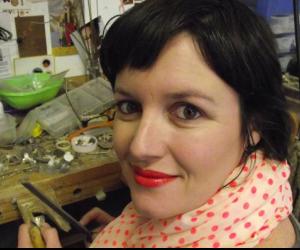First Published in
The returnee
Beverley Price is best known for her lightweight foil and image jewellery that incorporates images such as iconic South African brands, Drum magazine, Frida Kahlo and, most recently, Nobel laureates.
However, Price's development as a jeweller has been driven by her attitude towards gold. Studying overseas in Israel and London during the 1980s, she returned in 1994. Arriving in Johannesburg during transformation, she made a conscious decision not to work in precious materials due to the local mining history. By challenging herself to find other ways of making jewellery, she came upon her foil and image method, and was encouraged to pursue studies in fine art.
Years later, as an iconic South African jeweller, she returned to gold after learning about and researching Mapungubwe, a community of the finest pre-colonial African goldsmiths, from the Limpopo Province. Based on this, she developed her Mapungubwe Re-Mined neckpiece for Anglo Gold Ashanti.
"I returned to gold on my terms, where I felt that I could work with a clear conscience. I also feel strongly that Mapungubwe should be acknowledged as the true origin of gold in South Africa, rather than the white settlers," Price explains. She is launching a second Anglo Gold Ashanti piece in October.
The storyteller
Using an over-the-top cutesy kitsch aesthetic and archetypal motifs from the best of childhood memories, Geraldine Fenn crafts each piece of jewellery to encourage the wearer to open a multitude of stories.
"I've always loved miniatures. Very mundane things become cute when they're so small and it's easy to create a story just by putting different things together in the same context," explains Fenn, who arrived at jewellery design when she went in search of an alternative to her academic background in archaeology and classical history.
Having run her own studio since 1999, she joined Jaci Jenkins as a partner in contemporary jewellery outlet Tinsel in 2006. Although Tinsel opened its second branch this year in Cape Town, the business has been a constant challenge in terms of facing local consumer preferences for mass-produced costume jewellery, rather than original handmade designs that defy preconceptions of jewellery.
This experience probably informs Fenn's mixed feelings towards gold. "18ct gold is one of the most wonderful metals to work with and has a beautiful rich gold colour, but I've always hated jewellery that uses gold excessively just to show off the owner's wealth - then it's just about the monetary value of the material and not its beauty."
The youth
Although Deirdre Coleman says that her passion is for found objects, one is more struck by the negative spaces in her designs. It is as though her precious metals, plastic bottle-tops, gems and tin-pull tops are more interested in capturing glimpses of air than showing themselves off.
"Jewellery is not only about the object itself, as it is always going to be shown in a specific space, the body. I think about the shape and form of the jewellery, as well as what it will look like on the wearer," says Coleman, whose newest range, Organic, takes inspiration from how each piece of nature is the same but unique.
Only 28 years old, Coleman graduated from Stellenbosch University just a couple of years ago and has taken the immediate plunge into opening up her own business, Didi Design.
Unlike the other designers, Coleman is still quite open to gold. "The purer the metal, the richer the colour and the more I work with it the more I realise why it is so precious. I think there is a place for all materials in jewellery, but it is about knowing how to choose and what your aims are," she says.
The foreigner
Philippe Bousquet was lured from France to South Africa in 2004 after he met, loved and married Tanja. Drawing on his skill in precious metals and her penchant for lampwork glass beads, the pair established Bousquet Creations.
Originally a frustrated architect, Bousquet is a self-taught silversmith who became interested in jewellery as a means to unleash his repressed creativity. Becoming a full-time jewellery designer in 1997, he also realised the limitations of jewellery and began to explore small sculptures that take on social, political or religious meaning.
Apparently the African sun has melted Bousquet's European ways. "It was a normal evolution for me to abandon the precious metals to work more with 'junk', while still using the mind of a silversmith in looking for materials and details," Bousquet explains the recent turn of his style, which was recognised when two of his works were finalists in the 2008 Most Beautiful Object in South Africa competition.
As for gold, Bousquet doesn't feel much for it. "I had the fever when I was living in France and in the begining in SA. Today I don't use it any more because it is often just an impressive weapon to hide a poor idea."




















